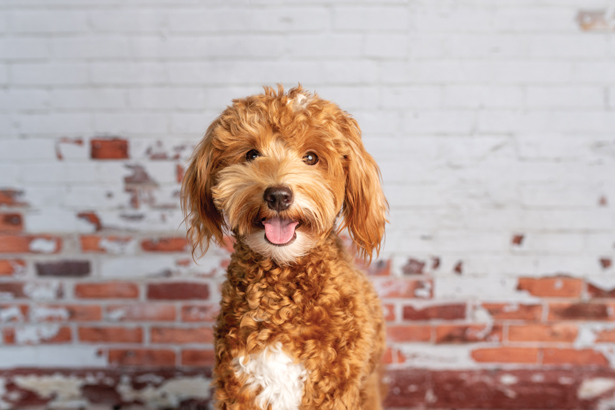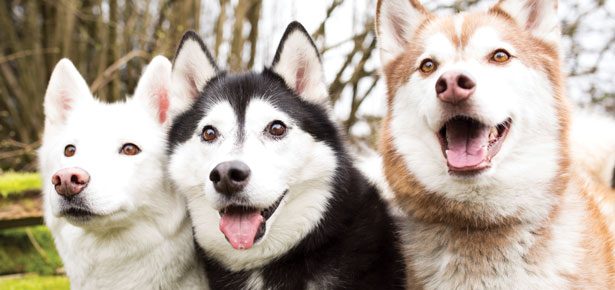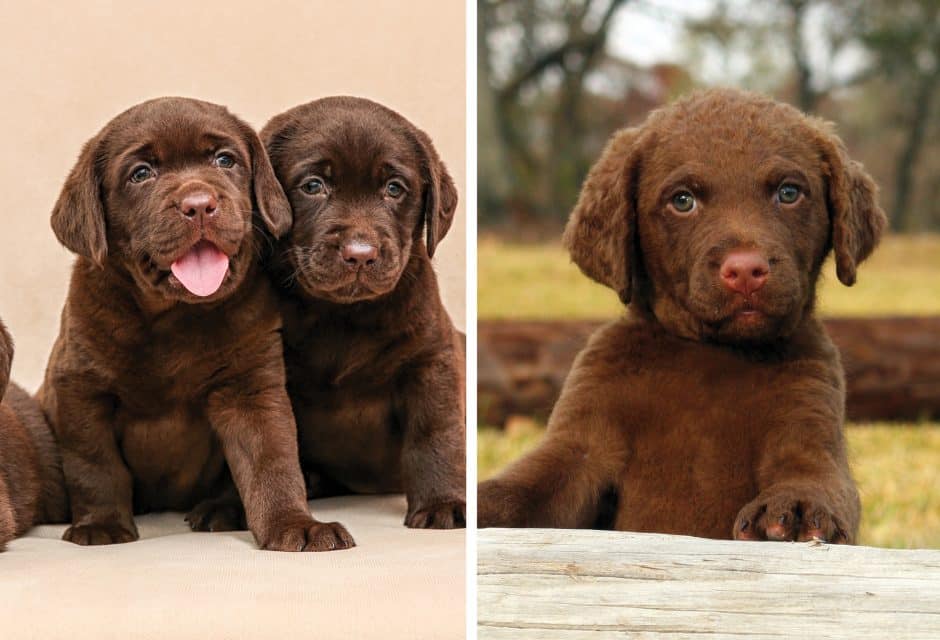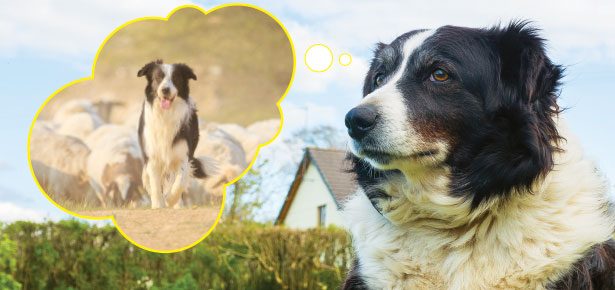
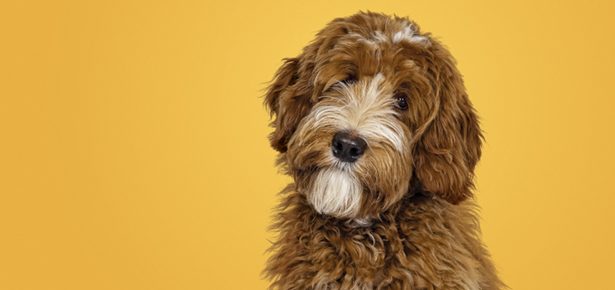
The Rise of the Doodle
The hybrid dog trend is all the rage, but is it a trend worth keeping?
What do you get when you mix a Lab and a Poodle? If you answered a fun-loving, active, non-shedding mutt with a wavy coat, you’d be partly right, but way behind the times. The correct answer of course is “Labradoodle.”
“Sheila is such a wacky love,” says Emily B. from Seattle, mother of two young daughters. Now two years old, Sheila the Goldendoodle seems a perfect fit for her active family. “She’s a clown,” says Emily. “She’ll get the zoomies, then conk out until the kids come home from school. Then it’s full steam ahead again.” Emily says she and her husband got Sheila because one of the children has allergies. “We paid $3,000, but feel it was well worth the price.”
With a recent explosion in popularity, “hybrid” dogs have become the latest canine sensation. These trendy designer mutts, with neologic names like Labradoodle, Schnoodle, Puggle, Chug, Cadoodle, Foodle, and Malti-poo, have won over many hearts. Traditional breeders, however, see the hybrid trend as a threat to the well-being of all dogs, be they purebred or not. What’s the truth?
What Exactly is a Hybrid Dog?
When purebred dogs mate, the resulting offspring is not technically a hybrid, as is a mule. The resulting puppy is instead a crossbreed, not a hybrid. Nevertheless, the use of the term “hybrid” to describe the intentional crossing of two established breeds seems to have caught on.
How do these designer dogs differ from the average shelter mutt? The answer depends more on intent and timing than on actual biology. A “mongrel,” or mixed breed dog usually results from the unintentional crossing of two purebred dogs, or a purebred and a mixed breed, or from the pairing of two mixed breeds. Hybrids, however, result when a breeder purposely crosses two different breeds with the intent of producing unique offspring with specific beneficial qualities.
For example, those mating a Labrador retriever to a Standard (or Miniature) Poodle hope to produce a litter of “Labradoodle” puppies with the intelligence, health, and sociability of both breeds, as well as the promise of a non-shedding coat, courtesy of the Poodle bloodline. In practice, some in that first litter will possess the non-shedding quality, while others may keep the Lab’s characteristic shedding coat. That’s just how genetics works. And even if the resulting dog does not shed, it, like all dogs, still produces skin dander and saliva, both of which contain the protein-based allergen. It just does not get distributed as profusely.
The Hybrid Debate
Not surprisingly, the hybrid trend brews controversy.
Wally Conron is the person credited with breeding the first Australian Labradoodle puppies, back in the late 1980s. His initial motivation: to provide a blind woman with a hypo-allergenic guide dog, as her husband was allergic to pet dander. Famously, Conron has since stated that he regrets starting the trend, and that he “opened a Pandora Box and released a Frankenstein monster.” He says he birthed a demand that “unethical, ruthless” breeders were more than happy to meet. Conron feels that the surging popularity of the Labradoodle has caused an explosion of “puppy mill” breeders, whose desire for profits has resulted in a rash of ill-behaved dogs.
“Famously, Conron has since stated that he regrets starting the trend, and that he ‘opened a Pandora Box and released a Frankenstein monster’.”
Today, prices charged for these designer puppies can cost upwards of $5,000–substantially more than what one might pay for many purebred dogs. They also ask the ethical question: why buy an overpriced designer dog when thousands of needy “hybrid” mutts beg to be adopted at shelters across the country?
Darryl Garmin, a dedicated Australian Labradoodle breeder in Washington state, agrees that the recent rush for Doodle puppies convinced some profiteers that there was easy money to be made there. That, he thinks, does not help the Doodle’s reputation. He also believes that some of the anti-Doodle sentiment comes from those who see the lack of American Kennel Club (AKC) recognition as a sign that his dogs are not an authentic breed.
The breeding “arithmetic” doesn’t always work out with hybrids. For instance, if, in an attempt to reduce the barking inherent to a Beagle, one is bred to a Greyhound (normally a quiet breed), you are not guaranteed a quiet dog. The Beagle’s innate desire to bark may simply be passed along to the offspring (a Greagle?). If beneficial traits can be passed on to the hybrid dog, so too can undesirable ones.
When new breeds have been created in the past, it has been for a specific purpose. The Bullmastiff began by crossing the Mastiff with the Bulldog, with the purpose of creating a more effective anti-poacher dog. What’s
the function of a Labradoodle? If to simply produce a dog with a somewhat hypo-allergenic coat, why not just breed Poodles?
“All purebred dogs, at some point, were crossbreeds,” says Colleen McDaniel, owner of The Academy of Canine Behavior in Bothell, WA. In addition to training dogs, McDaniel has bred Irish Water Spaniels–a non-shedding purebred dog— for decades. “But purebred actually is purpose-bred. The crosses were done to achieve a type of dog that would better perform some specific task. Although there are those who breed hybrids for some perceived purpose, the majority breed for looks, for financial advantage, and for some questionable hypo-allergenic status.”
With regard to temperament and health, McDaniel adds: “Hybrids themselves, as individuals, have the same possibilities to be temperamentally good or bad, healthy or unhealthy, and cared for or neglected. They aren’t a magical unicorn.”
Proponents of hybrids emphasize that there are legitimate reasons for breeding some of these crosses, notably to provide non-shedding pets for dog-loving people with allergies. And with regard to the allegation that hybrid customers should instead be adopting and saving shelter dogs, the argument can be made that those who are ready and willing to purchase an expensive hybrid aren’t likely to adopt a shelter dog in the first place. These customers know what they want and are willing to pay for it.
Photo: Tanya Consaul/shutterstock.com
Hybrid Vigor
Hybrid lovers claim that purebred pets lose breed “vigor” or overall breed health because of small gene pools and in-breeding. They claim that their crossbreedings, however, result in a hybrid vigor, returning a healthy genetic diversity to the mix.
Hybrid breeders are confident that their dogs have healthier genetic profiles than purebred dogs. Though valid in the case of the initial crossing of two dissimilar breeds, the “vigor” argument does lose steam once the multi-generational litters are produced.
Oh Behave!
As a trainer with over 20 years of experience, Arizona-based Katie Webb addresses the Doodle issue from a behavioural perspective. “I find it odd that two extremely energetic sporting breeds (Poodle and Lab) are being crossbred to create a supposed family dog. Both breeds, purposely bred to hunt and swim, are extremely active.” Webb adds: “Without regular stimulation, exercise, and training, Doodles can develop anxiety issues, which I see regularly.” She adds that shedding issue aside, she usually recommends a Golden Retriever for families with children. “Though active, they also have a relaxed side that lends itself better to family living. They don’t get the “zoomies” as often as Doodles.”
McDaniel in Washington agrees and says that her training facility sees an inordinate number of Doodles come in for a host of behavioural issues due, she thinks, to inexperienced breeders using questionable breeding stock.
Popularity Promotes Problems
Increased interest in certain breeds or hybrids due to popularity surges over the years can cause an explosion of profit-motivated “backyard” breeding, ballooning the gene pool but damaging the overall genetic health of the breed. Opportunists will breed and sell any dog, even those with profound hereditary problems. The health and behavioural stability of Dalmatians, Cocker Spaniels, Rottweilers, Pit Bulls, Collies, French Bulldogs, and other breeds, have at one time or another, all suffered from this. Once the trend fades, however, the breed in question tends to stabilize, both physically and behaviourally. There is no reason that this stabilization cannot apply to hybrids.
Can a Hybrid become a Breed?
As McDaniel stated earlier, most recognized breeds at some point began as crossbreeds or “hybrids.” For instance, the German Shepherd traces its beginnings back to the late 19th century, when a small number of “hybrid” devotees decided to create an intelligent, adaptable, “super” dog capable of many behaviours. In effect, the German Shepherd started out as a “hybrid.” So did the Chesapeake Bay Retriever, bred from Newfoundland, Setter, and Spaniel stock.
Whether or not any of today’s hybrids will ever attain official AKC breed status remains to be seen. But if it has happened before, it can certainly happen again.
Doodle Futures
Though the incentive of some hybrid breeders remains profit, others, such as Daryl Garmin, are impassioned about their dogs, perhaps in the same manner that traditional breed pioneers of the past were. Determination and perseverance eventually paid off with the birth of new breeds like the Bullmastiff, the Australian Cattle Dog, the German Shepherd and the Chesapeake Bay Retriever, all now welcomed members of the AKC. If the motivations of devoted Doodle breeders are to sincerely create a better breed, then perhaps holding off judgement for a bit longer might just give them that chance?
This article originally appeared in the award-winning Modern Dog magazine. Subscribe today!
Join the newsletter and never miss out on dog content again!
"*" indicates required fields
By clicking the arrow, you agree to our web Terms of Use and Privacy & Cookie Policy. Easy unsubscribe links are provided in every email.
